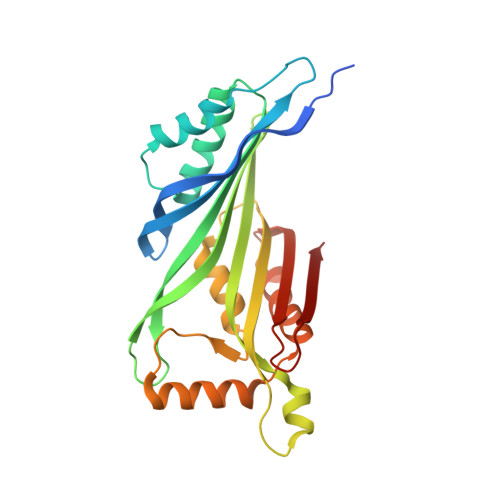Zinc-independent folate biosynthesis: genetic, biochemical, and structural investigations reveal new metal dependence for GTP cyclohydrolase IB
Sankaran, B., Bonnett, S.A., Shah, K., Gabriel, S., Reddy, R., Schimmel, P., Rodionov, D.A., de Crecy-Lagard, V., Helmann, J.D., Iwata-Reuyl, D., Swairjo, M.A.(2009) J Bacteriol 191: 6936-6949
- PubMed: 19767425
- DOI: https://doi.org/10.1128/JB.00287-09
- Primary Citation of Related Structures:
3D2O - PubMed Abstract:
GTP cyclohydrolase I (GCYH-I) is an essential Zn(2+)-dependent enzyme that catalyzes the first step of the de novo folate biosynthetic pathway in bacteria and plants, the 7-deazapurine biosynthetic pathway in Bacteria and Archaea, and the biopterin pathway in mammals. We recently reported the discovery of a new prokaryotic-specific GCYH-I (GCYH-IB) that displays no sequence identity to the canonical enzyme and is present in approximately 25% of bacteria, the majority of which lack the canonical GCYH-I (renamed GCYH-IA). Genomic and genetic analyses indicate that in those organisms possessing both enzymes, e.g., Bacillus subtilis, GCYH-IA and -IB are functionally redundant, but differentially expressed. Whereas GCYH-IA is constitutively expressed, GCYH-IB is expressed only under Zn(2+)-limiting conditions. These observations are consistent with the hypothesis that GCYH-IB functions to allow folate biosynthesis during Zn(2+) starvation. Here, we present biochemical and structural data showing that bacterial GCYH-IB, like GCYH-IA, belongs to the tunneling-fold (T-fold) superfamily. However, the GCYH-IA and -IB enzymes exhibit significant differences in global structure and active-site architecture. While GCYH-IA is a unimodular, homodecameric, Zn(2+)-dependent enzyme, GCYH-IB is a bimodular, homotetrameric enzyme activated by a variety of divalent cations. The structure of GCYH-IB and the broad metal dependence exhibited by this enzyme further underscore the mechanistic plasticity that is emerging for the T-fold superfamily. Notably, while humans possess the canonical GCYH-IA enzyme, many clinically important human pathogens possess only the GCYH-IB enzyme, suggesting that this enzyme is a potential new molecular target for antibacterial development.
Organizational Affiliation:
Berkeley Center for Structural Biology, Lawrence Berkeley National Laboratory, 1 Cyclotron Road, Berkeley, California 94720, USA.


















